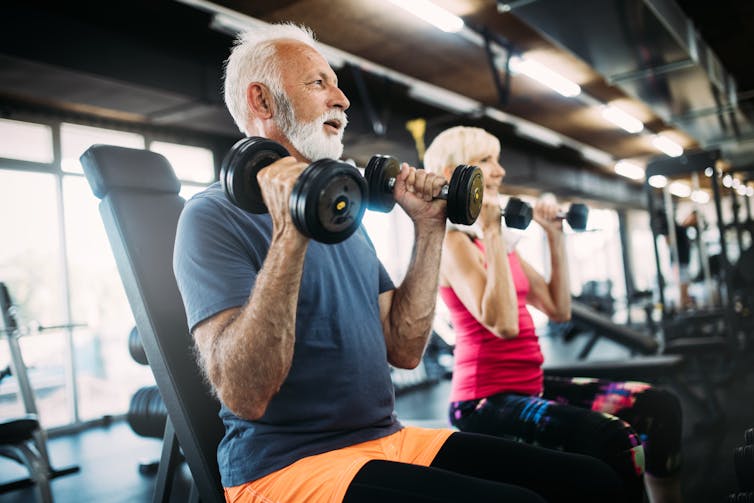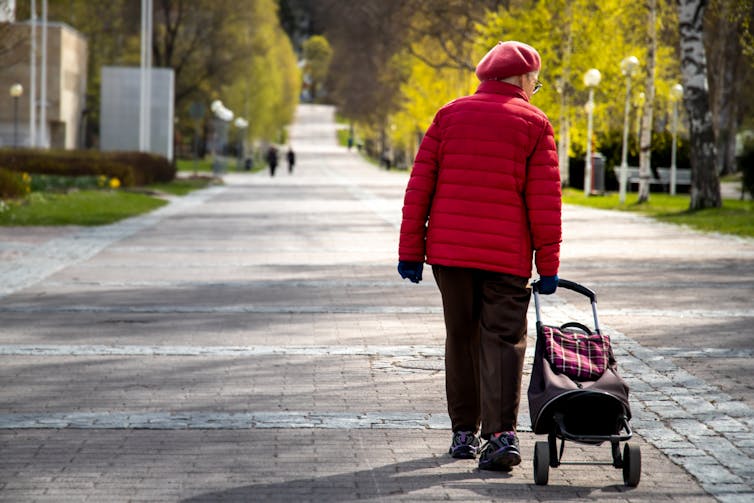
NDAB Creativity/ Shutterstock
Bradley Elliott, University of Westminster
It’s a common assumption that exercise in older people is difficult and dangerous, so it’s perhaps best avoided. But this is often not the case – even if these ideas are ingrained in society. Research has repeatedly shown that exercise in older adults is linked with lower disease risk, reduced risk of falls, and better overall health.
But misconceptions about age and exercise still exist – and it’s not difficult to see why. Exercise recommendations, even from health authorities, are often based on age. But if you look closer, you notice that these recommendations are often identical to those for younger people, with the differences being in assumptions of ability.
Indeed, it’s true that as you age you lose muscle strength, bone density, and your body composition shifts from muscle to fat. However, research shows exercise training at any age results in positive gains in muscle mass, muscle strength, bone density, and improvements to overall health – even in people as old as 97.
Safety is also a commonly perceived barrier when exercising at an older age. However, it appears that the benefits of exercise, both aerobic and resistance, outweigh the risks of injury or cardiovascular events.
When choosing what type of exercise to do, it’s your ability – not your age – that should be your primary consideration. Older people are more likely to suffer from one or more age-related diseases or health conditions (such as type 2 diabetes, osteoarthritis, heart disease and stroke) that may affect their ability to take exercise. But risk of and recovery from these conditions are all positively influenced by daily exercise. Even arthritis symptoms can be reduced by low-impact movements.
Ability, not age
So, what type of exercise should you be doing? Prescribing training based on a person’s age is too simplistic, as people can be very different from one another. For example, I’ve meet both frail 65-year-olds and others that can outpace me on the track. Exercise prescription should be done by ability. And, whichever mode you choose, remember it should always challenge you.
Maintaining a high level of low-intensity activity (such as walking, jogging or cycling) is a lifestyle choice correlated with longevity. Given that almost 50% of UK adults don’t meet minimum activity guidelines, this is an immediate positive impact that people can have on their fitness and health, both through the benefits of being active and by off-setting the negative health affects of being sedentary.

Bauwimauwi/ Shutterstock
Simply moving around more is a great way of maintaining fitness and general health. For example, standing up every ad break when watching TV, walking to the shops instead of driving, or taking the stairs are all great ways of increasing activity.
However, other types of workouts may also have similar benefits for older people. High intensity interval training (HIIT) exercise, which involves exercising at (or near) 100% effort for short bouts followed by rest, is a popular form of aerobic training. While HIIT training is often assumed to be only for those who are athletic or young, our research shows that HIIT training in both in older men and pre-diabetic older men and women, is beneficial to overall health. It’s worth noting that we used stationary bikes for safety, as an intense bout of HIIT exercise may make people of all ages can feel a bit faint.
And, when HIIT training incorporates leg balance and strength exercises, there’s both perceived and actual decreases in fall risk in older people, as well as cardiovascular improvements.
Resistance training, or exercises that require your maximal strength, is also a great option for people of every age. Not only will many older people be capable of performing resistance training, they will also benefit greatly from it – with studies showing strength and resistance training improves bone density, muscle mass, and physical ability.
Resistance training also doesn’t need to involve heavy weights in a gym, but as a general guide the movement should be challenging and near the limit of your strength if repeated about ten times. For example, performing a chair squat (getting up from a seated position repeatedly) can be made harder by holding weights, cans, or even a bottle of milk. It can be made harder still by balancing on one leg as you stand up.
While older people are likely to gain muscle mass and strength from exercise, it does get harder to build muscle tissue as you age. Even elite athletes, who maintain lifelong high levels of training see decreases in performance as they age.
But fitness isn’t the only positive change from exercise. Exercise is also shown to improve mental health, well-being and cognitive function, alongside improved bone density and longer life. Improved bone density from weight lifting may also minimise injury if an older person does have a fall.
Balance is also an important skill at any age – and this skill can be trained. Improved balance may prevent falls or injuries from falls in older people. Activities such as yoga or tai chi may improve balance. But even something as simple as standing on one leg while putting your socks on can challenge your balance.
A great combination of strength and balance exercises are “asymmetric exercises” which involve moving only one side of the body at a time. This can be as simple as balancing on one foot whilst moving the other leg back and forth, or using one arm at a time to perform a lifting or throwing movement to challenge and improve balance.
In short, the best type of exercise – regardless of your age – has already been outlined by the NHS. Aim to be physically active daily, do activities that improve strength, flexibility and balance at least two days a week, get at least 150 minutes of moderate intensity activity or 75 minutes of vigorous intensity activity a week, and reduce time spent sitting or lying down. And no matter your age or ability, do exercises that continue to challenge you.![]()
Bradley Elliott, Lecturer in Physiology, University of Westminster
This article is republished from The Conversation under a Creative Commons license. Read the original article.
